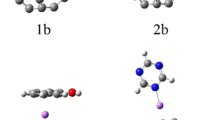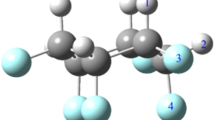Abstract
We present a theoretical investigation of the electric properties of two kinds of one-dimensional lithium bonded chains: (NC-Li)n and (NC-CC-Li)n (n = 1–8). The resulting (NC-Li)n and (NC-CC-Li)n were found to exhibit enhanced first hyperpolarizabilities (β 0) with increasing n, and a slight change in the absorption maximum wavelength λmax at the crucial transition. Comparing with (NC-Li)n, (NC-CC-Li)n exhibited particularly drastically enhanced β 0 values due to clearly enhanced coupled oscillators and double-degenerated charge transitions. β 0 is known to be the microscopic origin of the second-order non-linear optical (NLO) property, and λmax is an approximate measure of the transparency achievable, thus both are important indices of high-performance NLO molecules. Therefore, our investigations into one-dimensional lithium bond chains will be beneficial to understanding the relationship between β 0 and λmax, thus aiding the design of one-dimensional NLO materials with excellent transparence-efficiency.

One-dimensional lithium bond complexes (NC-Li)n and (NC-CC-Li)n showing the π-Li-bond-π interactions investigated. The resulting (NC-Li)n and (NC-CC-Li)n exhibited enhanced first hyperpolarizabilities (β 0) with increasing n, and a slight change in the absorption maximum wavelength λmax at the crucial transition.







Similar content being viewed by others
References
Coe BJ, Jones LA, Brunschwig BS, Asselberghs I, Clays K, Persoons A (2003) Highly unusual effects of π-conjugation extension on the molecular linear and quadratic nonlinear optical properties of ruthenium(II) ammine complexes. J Am Chem Soc 125:862–863
Champagne B, Perpete EA, Jacquemin D, Gisbergen SJA, Baerends EJ, Ghaoui CS, Robins KA, Kirtman B (2000) Assessment of conventional density functional schemes for computing the dipole moment and (hyper)polarizabilities of push–pull π-conjugated systems. J Phys Chem A 104:4755–4763
Boyd RW (1992) Nonlinear optics. Academic, San Diego
Zyss J (1994) Molecular nonlinear optics: materials, physics and DeVices. Academic, New York
Nalwa HS, Miyata S (1997) Nonlinear optics of organic molecules and polymers. CRC, Boca Raton
Torre G, Vázquez P, López FA, Torres T (2004) Role of structural factors in the nonlinear optical properties of phthalocyanines and related compounds. Chem Rev 104:3723
Leu WCW, Hartley CS (2013) A push–pull macrocycle with both linearly conjugated and cross-conjugated bridges. Org Lett 15:3762–3765
Kaur P, Kaur M, Depotter G, Cleuvenbergen SV, Asselberghs I, Clays K, Singh K (2012) Thermally stable ferrocenyl “push–pull” chromophores with tailorable and switchable second-order non-linear optical response: synthesis and structure–property relationship. J Mater Chem 22:10597–10608
Lacroix PG, Malfant I, Real J, Rodriguez V (2013) From magnetic to nonlinear optical switches in spin-crossover complexes. Eur J Inorg Chem 2013:615–627
Zhang X, Li M, Shi Z, Cui Z (2011) Prepare organic/inorganic hybrid nonlinear optical material containing two-dimensional spindle-type chromophores. Mater Lett 65:1404–1406
Oudar JL, Chemla DS (1977) Hyperpolarizabilities of the nitroanilines and their relations to the excited state dipole moment. J Chem Phys 66:2664–2668
Moylan CR, Twieg RJ, Lee VY, Swanson SA, Betterton KM, Miller RD (1993) Nonlinear optical chromophores with large hyperpolarizabilities and enhanced thermal stabilities. J Am Chem Soc 115:12599–12600
Shenning APHJ, Kinbinger AFM, Biscari F, Cavallini M, Cooper HJ, Derrick PJ, Feast WJ, Lazzaroni R, Leclère P, McDonnell LA, Meijer EW, Meskers SC (2002) Supramolecular organization of α, α‘-disubstituted sexithiophenes. J Am Chem Soc 124:1269–1275
Quintiliani M, Pérez-Moreno J, Asselberghs I, Vázquez P, Clays K, Torres T (2010) Synthesis and nonlinear optical properties of tetrahedral octupolar phthalocyanine-based systems. J Phys Chem B 114:6309–6315
Poronik YM, Hugues V, Blanchard-Desce M, Gryko DT (2012) Octupolar merocyanine dyes: a new class of nonlinear optical chromophores. Chem Eur 18:9258–9266
Zrig S, Koeckelberghs G, Verbiest T, Andrioletti B, Rose E, Persoons A, Asselberghs I, Clays K (2007) Λ-type regioregular oligothiophenes: synthesis and second-order NLO properties. J Org Chem 72:5855–5858
Moylan CR, Ermer S, Lovejoy SM, McComb I, Leung DS, Wortmann R, Krdmer P, Twieg RJ (1996) Dicyanomethylene)pyran derivatives with C2v symmetry: an unusual class of nonlinear optical chromophores. J Am Chem Soc 118:12950–12955
Yang M, Champagne B (2003) Large off-diagonal contribution to the second-order optical nonlinearities of Λ-shaped molecules. J Phys Chem A 107:3942–3951
Méreau R, Castet F, Botek E, Champagne B (2009) Effect of the dynamical disorder on the second-order nonlinear optical responses of helicity-encoded polymer strands. J Phys Chem A 113:6552
Shigorin DN (1959) Infra-red absorption spectra study of H-bonding and of metal-element bonding. Spectrochim Acta 14:198–212
Ault BS, Pimental GC (1975) Matrix isolation infrared studies of lithium bonding. J Phys Chem 79:621
Sannigrahi AB, Kar T, Niyogi BG, Hobza P, Schleyer PR (1990) The lithium bond reexamined. Chem Rev 90:1061
Tong J, Li Y, Wu D, Li ZR, Huang XR (2010) Lithium bonding interaction hyperpolarizabilities of various Li-bond dimers. J Phys Chem A 114:5888–5893
Wang BQ, Li ZR, Wu D, Hao XY, Li RJ, Sun CC (2004) Lithium bonding interaction hyperpolarizabilities of various Li-bond dimers. J Phys Chem A 108:2464
Aakeröy CB, Beatty AM, Helfrich BA (2001) Total synthesis” supramolecular style: design and hydrogen-bond-directed assembly of ternary supermolecules. Angew Chem Int Ed 40:3240–3242
Solomon PM (1973) Interstellar molecules. Phys Today 26:32–40
Niemann HB, Atreya SK, Bauer SJ, Carignan GR, Demick JE, Frost RL, Gautier D, Haberman JA, Harpold DN, Hunten DM, Israel G, Lunine JI, Kasprzak WT, Owen TC, Paulkovich M, Raulin F, Raaen E, Way SH (2005) The abundances of constituents of Titan’s atmosphere from the GCMS instrument on the Huygens probe. Nature 438:779–784
Powner MW, Gerland B, Sutherland JD (2009) Synthesis of activated pyrimidine ribonucleotides in prebiotically plausible conditions. Nature 459:239–242
Reed AE, Weinstock RB, Weinhold F (1985) Natural population analysis. J Chem Phys 83:735–746
Carpenter JE, Weinhold F (1988) Analysis of the geometry of the hydroxymethyl radical by the “different hybrids for different spins” natural bond orbital procedure. J Mol Struct (THEOCHEM) 169:41
Boys SF, Bernardi F (1970) The calculation of small molecular interactions by the differences of separate total energies. Some procedures with reduced errors. Mol Phys 19:553–566
Yamazaki S, Taketsugu T (2012) Photoreaction channels of the guanine–cytosine base pair explored by long-range corrected TDDFT calculations. Phys Chem Chem Phys 14:8866–8877
Stratmann RE, Scuseria GE, Frisch MJ (1998) An efficient implementation of time-dependent density-functional theory for the calculation of excitation energies of large molecules. J Chem Phys 109:8218
Frisch MJ et al (2010) Gaussian 09W, revision A.02. Gaussian, Inc, Wallingford
Politzer P, Murraya JS, Clark T (2012) Halogen bonding: an electrostatically-driven highly directional noncovalent interaction. Phys Chem Chem Phys 12:7748–7757
Politzer P, Riley KE, Bulat FA, Murray JS (2012) Perspectives on halogen bonding and other σ-hole interactions: Lex parsimoniae (Occam’s Razor). Comput and Theor Chem 998:2–8
Tong J, Li Y, Wu D, Wu ZJ (2013) Theoretical study of substitution effect in superalkali OM3 (M = Li, Na, K). Chem Phys Lett 575:27
Oudar JL (1977) Optical nonlinearities of conjugated molecules. Stilbene derivatives and highly polar aromatic compounds. J Chem Phys 67:446–457
Ma F, Li ZR, Xu HL, Li ZJ, Li ZS, AokiY GFL (2008) Lithium salt electride with an excess electron pair—a class of nonlinear optical molecules for extraordinary first hyperpolarizability. J Phys Chem A 112:11462–11467
Xu HL, Li ZR, Wu D, Ma F, Li ZJ, Gu FL (2009) Lithiation and Li-doped effects of [5]cyclacene on the static first hyperpolarizability. J Phys Chem C 113:4984–4986
Acknowledgments
This work was supported by the National Natural Science Foundation of China (No. 21303065 and 21473026), the Natural Science Foundation of Anhui Province (No. 10040606Q55) and Anhui University Natural Science Research Project (No.KJ2013B242)
Author information
Authors and Affiliations
Corresponding authors
Electronic supplementary material
Below is the link to the electronic supplementary material.
ESM 1
NBO charge, the hyperpolarizabilities of (NC-Li)4 and (NC-CC-Li)4 in different applied electric fields, a comparison of the results between CIS and TD-DFT(LC-BLYP), and electrostatic potentials on (NC -Li)n. (DOC 1418 kb)
Rights and permissions
About this article
Cite this article
Ma, F., Bai, D. & Xu, H. A theoretical investigation of one-dimensional lithium-bonded chain: enhanced first hyperpolarizability and little red-shift. J Mol Model 20, 2532 (2014). https://doi.org/10.1007/s00894-014-2532-x
Received:
Accepted:
Published:
DOI: https://doi.org/10.1007/s00894-014-2532-x




